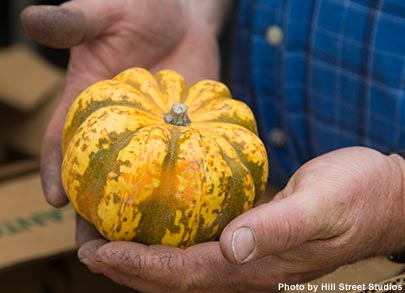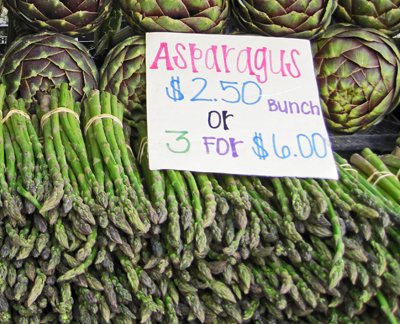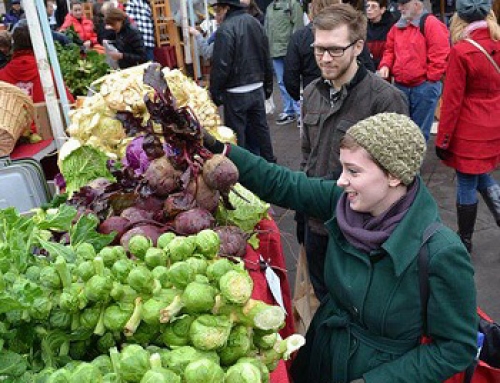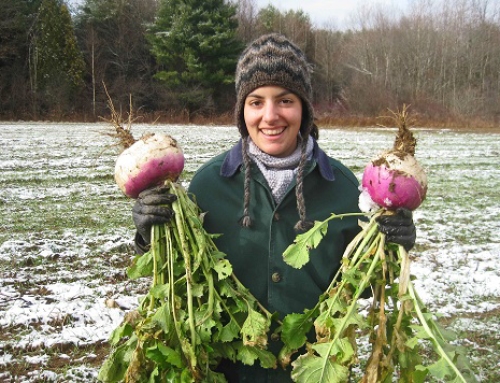Whenever I’m asked if farmers’ markets are expensive or elitist, I think to myself, when did buying our food from truck farmers in a parking lot become la-di-dah?
On the other hand, there’s a moment in the documentary film, Food, Inc., when a financially strapped family of four decides it can’t afford to buy broccoli and often resorts to fast food breakfasts for about $14. Where exactly do my everyday farmers’ market meals fit in? How much do they cost? I ran some numbers on a recent midweek dinner.
For more tips to navigate the market, join my next Santa Monica Farmers’ Market Tour>
In the time it took to preheat the oven and bring a pot of water to boil, I rubbed a whole, fresh chicken ($13, truly free-range, hormone-and-antibiotic-free) with salt; halved and seeded two late-season Sweet Dumpling squashes ($1, Vitamin A, fiber), trimmed and chopped a lavish bunch of Siberian kale ($2, B-vitamins, iron), and set the table. While the chicken and squash roasted (the latter brushed with olive oil, seasoned with salt and red pepper flakes, placed cut side down on a sheet pan), I flash-boiled the kale and drained it well.
All that was left to do was baste the chicken once and dress the kale with olive oil and lemon, leaving me plenty of time to go through the mail and pour a glass of wine (if you’ve got kids, substitute homework duty for the cocktail hour…for now). Total cost for a healthy weekday dinner for four, or two for two nights, plus one lunch and a carcass to enrich a soup: $16, 15 minutes prep, 1 hour roasting time.
And if there is only 15 minutes to prepare dinner, no matter how much multi-tasking I do, I quick-poach fish ($10, line-caught, or use cubed chicken breast for less $$) in a little water and rice vinegar with snap peas, bok choy, green or regular garlic, scallions, and fresh ginger ($4) and a handful of early cherry tomatoes if I’ve got them ($2).
True, I don’t live in a food desert, do shop at a market known for its chef appeal, and do have the funds (but not always enough time) to cook whatever I want. But here’s what disturbs me. Many who share this same access do not support farmers’ markets or other resources for small-farmed foods because they think they’re too expensive.
I ran more numbers: farmers’ market asparagus—$2.50 per bunch (3 for $6); at the supermarket—$3.99; farmers’ market avocados (multiple varieties)—50 cents to $1.50 each; supermarket equivalent (Hass only)—$2.99; bunched greens (chard, bok choy)—$1 versus $2. It was a chichi-busting exercise. Compare differences in flavor, freshness, and farming practices, or pit raw ingredients against the hidden health costs of “cheaper” commodity crop-based processed foods, and the differential widens even more.
Clearly, there’s a great need for food education at all socio-economic levels. Here’s why it’s so important for those at the higher end of the ladder: you have the power to effect policy change, to improve the lot of families like the one in the film. But there’s a danger in making this only about helping those in need. It’s too easy to opt out or to kid ourselves we don’t need to improve our own habits, as though having enough money to buy food guarantees being smart about food at home.
Want more tips to make the most of the farmers’ market? Join my next Santa Monica Farmers’ Market Tour>










Leave A Comment